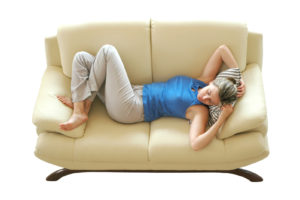Introduction
The science correlating clean air with health issues is still evolving. There is no standard definition of “Clean Air”. As a result, most standards for building indoor air quality (IAQ) are established based on people’s perception of air quality. In this article we will examine both perceived air quality and actual clean air. We will present our conclusion and recommendations for achieving the healthiest indoor air possible.
Comfortable Air
Perceived Air Quality (PAQ), as the name indicates, is the subjective assessment of air quality by those living in a home or working in a business environment. Home builders want to build homes that meet the wishes of the occupants. To determine what standards must be achieved to that end the builders conduct field studies in which sample subjects are exposed to different environment conditions, and their satisfaction with that environment is recorded.
A typical study [1] varied three levels of air temperature and humidity and two levels of ventilation rate. The values for temperature and relative humidity were:
20 Degrees C/ 40% RH, 23 Degrees C/ 50% RH,26 Degrees C/ 60%RH
Ventilation in these tests was set as:
10 liters/ second per person
3.5 liters/ second per person
Other studies [2] have examined the effect of CO2 on air perception quality.
WHAT THE STUDIES SHOW
These studies show that there is not a single value for the parameters studied that would assure an acceptable perceived air quality. The studies only show that air is perceived as acceptable when it is cool and dry and unacceptable when it is warm and humid. The ideal conditions depend on your geographical location and time of the year. Ideal Humidity is between 30% RH and 50% RH. For example Canadian standards recommend 35% RH in winter and 50% RH in summer
Other recommended values are CO2 less than 1000 ppm and ventilation rate above 0.5 air change rate per hour( or 14 liters/sec per person).
Other factors are also considered for improving comfort. For example a Danish labeling system for building primary emissions of volatile organic compounds (VOC) [3] focuses on comfort by minimizing annoying odors and mucous membrane irritation. The values of the VOCs should be below levels that can be sensed by the occupants. These levels have nothing to do with health impact. As we can see the emphasis is on maximizing the air quality perception, not the health of the building occupant.
Healthy Air
The science of clean air is still evolving. There is no standard definition of “clean air”. Scientific studies have focused on specific issues related to the ambient air such as the effects of radon, formaldehyde, sick building syndrome, air particulates, VOCs and ventilation. But all these studies were focused on the specific problems noted above. There is no single science branch that addresses all the above factors together as one subject. However, there is mounting evidence of the importance of indoor air pollution and lack of adequate ventilation in establishing a healthy air environment.Getting an Air Quality Monitor for your home is a good first step to improve your indoor air quality.WHAT SHOULD WE DO
From the individual studies we can conclude that to maximize healthy air we should try to achieve the following standards:
1) Our first priority should be to eliminate the fine particles (PM2.5) from the ambient air. These particles are smaller than 2.5 micrometers. Within that group the ultra fine particles, smaller than 0.1 micrometers, are the most harmful since studies show that they can easily trans locate from lungs to the blood system.
2) Eliminate environmental tobacco smoke (ETS). Do not smoke indoors!
3) Although there are not many studies on the health effects of inhaled biological particles or the various VOCs present indoors, it is common sense to eliminate as many VOCs from our indoors environment. These include fragrances, formaldehyde and other emissions from building materials.
4) Keep CO2 concentration below 1000 ppm.
5) Homes should be ventilated, as a minimum, at a rate of 7.5cfm (cubic feet per minute) per person plus 3 cfm per 100 square feet of the home.
These are general rules. A study from the Technical University of Denmark [4] sets the following goals for Indoor Air Quality in the 21st Century.
– Unnecessary indoor pollution sources should be avoided.
-The air should be served to the occupants cool and dry.
– “Personalized air”. Clean air should be introduced close to the breathing zone of each individual.
Conclusion
We certainly want a comfortable indoor environment so we should set our Air Conditioning accordingly. But we also want healthy air. Although the science for clean air is still evolving we should implement the common sense guidelines shown above. As a next step we may want to test our air quality to make sure that we are safe. Click here to find more about testing air quality..Clean air in our homes is our individual responsibility. Following the recommendation of the Technical University of Denmark we should provide personalized clean air by locating air purifiers in the proximity of the occupants if possible, or at least in the kitchen, living room and bedrooms where many of the indoor pollutants originate.

References
[1] Impact of indoor air temperature and humidity in an office on perceived air quality, SBS symptoms and performance. L.Fang et al., International Centre for Indoor Environment and Energy. Technical University of Denmark. 2004
[2] Association of Ventilation Rates and CO2 Concentrations with Health and Other Responses in Commercial and Institutional Buildings. O.A.Seppanen et. al, Wiley Online Library 2004
[3] A new approach for indoor climate labeling of building materials- emission testing, modeling, and comfort evaluation.Peder Wolkoff,Peter A.Nielsen in Atmospheric Environment Volume 30, Issue 15,August 1996
[4] Indoor Air Quality in the 21st Century: Search for Excellence/ P. Ole Fanger, Indoor Air/Volume 10,Issue 2., December 2001.

Carlos Gusts
carlos@improvingindoorairquality.com
Really interesting article on a subject that has obviously had a lot of attention from scientific quarters over the years – I had no idea that there were levels this delicate or important to our health.
Looking back I’m pretty sure that smoking is a big factor – when I think about the amount my dad smoked when we were kids, had no real idea the damage he was doing to everyone in the room at the time (and there were a lot of us!).
What air purifiers would you suggest or recommend as a starting point for a home?
Chris,Thank you for your comment.I mention several air purifiers in my article on air purifiers.You may want to check https://improvingindoorairquality.com/air-purifiers-who-needs-them
It’s so important not to smoke indoors I agree. Very informative article, this is such an important subject because it’s so imperative to our health and that of our families. I’ve read in the past about plants in the home that act as natural air purifiers. What do you think about the effectiveness of plants in the home?
I have plants in my home to help with air quality.I have spider plants and pothos.But I am not an expert in the subject.I know they help but I do not believe that plants alone will insure good air.
Hey there! Thanks for sharing this very interesting information about air quality. I found it surprising that there’s not really a definite way to measure air quality since it is something that really effects us and the planet. I do have a question. How can I tell how much CO2 I’m releasing in the air? You said not to release more than 1000 ppm, so how do I know that I’m releasing that amount or less?
You should buy an air quality monitor that reads CO2 concentrations.You may want to check out my article on ventilation . https://improvingindoorairquality.com/air-quality-monitors-do-you-need-one
Lately I have been reading more and more online about these air cleaners you can purchase and also how important they are to have in your home, as they enable you to breathe clean and fresh air as opposed to polluted air.
The trick is choosing the best machine to buy in order to do this. Also do you just buy one machine for your bedroom, or is it best to have a few scattered around your house.
I like your suggestions about what to do to maximize the air that we do breathe, like making sure there is enough ventilation and I am sure not smoking in the house will also make a huge difference to the quality of air that we breathe in. You say warm and humid air is not good to breathe in, however is it ok in a steam room situation?
Ideally you should have an air purifier where the pollutants are created such as kitchen and bathrooms and also in the bedrooms.People are more comfortable in cold and dry air.However, in a steam room you obviously have humid and warm air.That is ok but the steam room needs to be maintained so that mold does not grow.
Good day,
Nice article on indoor air condition. I have always worried about that because, I have allergies and my son in asthmatic.
Yes agree with you it is a personal responsibility. I use an air purifier and humidifier ho help with the “quality of air” at home. I notice that you made no mention of medical conditions that indoor air can create.
Yes, ventilation is an interesting factor since these particles are in the air and we live with them. Will continue to read some of your other articles on this very interesting subject for our health.
Thank you,
LadyEsther
LadyEsther,You are so right in using an air purifier and humidifier to keep the air clean if your son is asthmatic.Polluted air affects many respiratory conditions especially on children.I have a full article on health effects of Indoor Air Pollution.You can see the article in https://improvingindoorairquality.com/indoor-air-pollution-what-are-the-health-risks
Thanks for this article, it is really informative, I have always love receiving outdoor air but now I know how dangerous and good it can be to the body. I have always prefer indoor air because i believe it to be cleaned since it is not that contaminated with dust but I now know indoor can even be dangerous at times, thank you for this post it is really helpful.
Thanks for this article, it is really informative, I have always love receiving outdoor air but now I know how dangerous and good it can be to the body. I have always prefer indoor air because i believe it to be cleaned since it is not that contaminated with dust but I now know indoor can even be dangerous at times, thank you for this post it is really helpful.
What an interesting studies. I really do prefer dry and cool air over the humidity. And those small partical that can stay in Our lungs sounds scary. How can we test that the co2 is too high? What can we do to get rid of small particles? Is there a filter or a gadget that we can buy?
Your first step should be to find out what is the quality of your indoor air.You can see details in my post: https://improvingindoorairqual…
Hi Carlos, such an interesting read. The quality of air matters to us all whether you have an interest or not so I think that it is important that kids should be educated about this subject.
I am quite surprised that there is not really a way to measure the quality of the air given the technology that we have these days. It is really hard though in these times, so much pollution! Again it goes back to awareness and caring.
I have invested in home plants that purify the air and plan to purchase larger ones.
Thank you for putting the awareness out there. Much appreciated.
Hi Carlos, such an interesting read. The quality of air matters to us all whether you have an interest or not so I think that it is important that kids should be educated about this subject.
I am quite surprised that there is not really a way to measure the quality of the air given the technology that we have these days. It is really hard though in these times, so much pollution! Again it goes back to awareness and caring.
I have invested in home plants that purify the air and plan to purchase larger ones.
Thank you for putting the awareness out there. Much appreciated.
I found this post to be very interesting especially the part about the humidity levels. I live in a portion of the U.S. that in the Summer it is not unusual to experience high humidity levels sometimes up to 95%. Personally I love the humid weather. In fact I don’t have air conditioning. Humid air seems to give me energy. With all of the man-made items in my home I do worry about VOCs however.
I found this post to be very interesting especially the part about the humidity levels. I live in a portion of the U.S. that in the Summer it is not unusual to experience high humidity levels sometimes up to 95%. Personally I love the humid weather. In fact I don’t have air conditioning. Humid air seems to give me energy. With all of the man-made items in my home I do worry about VOCs however.
Hello, I have just begun researching ways to improve the air quality in a retail store. I want it to be comfortable for the customers. I need to ensure that the air is healthy for everyone – especially for the employees who spend a significant part of their days working in the store.
The store is located in an area that is very arid and windy. Fortunately, it is also located in an area where it smoking in not acceptable inside retail establishments. Dust, animal dander are the primary issues followed closely by exhaust fumes from vehicles in the parking lot and nearby highway. At the same time, I have been hesitant to use air freshers because so many people are sensitive to fragrances.
This article serves as a nice starting point into determining what I need to consider as I try to ensure that the store has both healthy and clean air. I suppose I should check out your page on air cleaners next. If you have a suggestion of what I should be sure to include in my reading, please let me know.
Hello, I have just begun researching ways to improve the air quality in a retail store. I want it to be comfortable for the customers. I need to ensure that the air is healthy for everyone – especially for the employees who spend a significant part of their days working in the store.
The store is located in an area that is very arid and windy. Fortunately, it is also located in an area where it smoking in not acceptable inside retail establishments. Dust, animal dander are the primary issues followed closely by exhaust fumes from vehicles in the parking lot and nearby highway. At the same time, I have been hesitant to use air freshers because so many people are sensitive to fragrances.
This article serves as a nice starting point into determining what I need to consider as I try to ensure that the store has both healthy and clean air. I suppose I should check out your page on air cleaners next. If you have a suggestion of what I should be sure to include in my reading, please let me know.